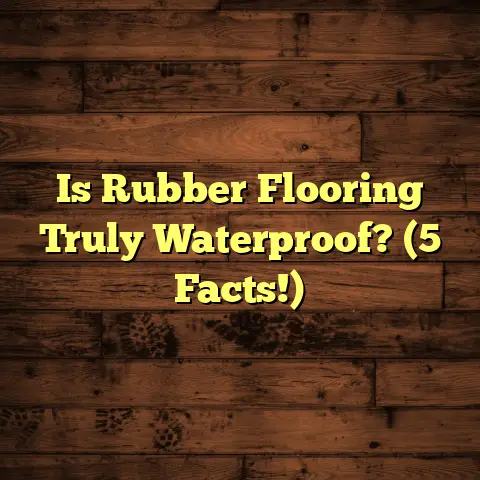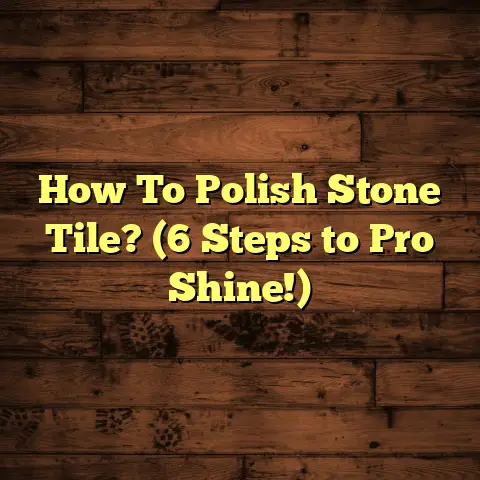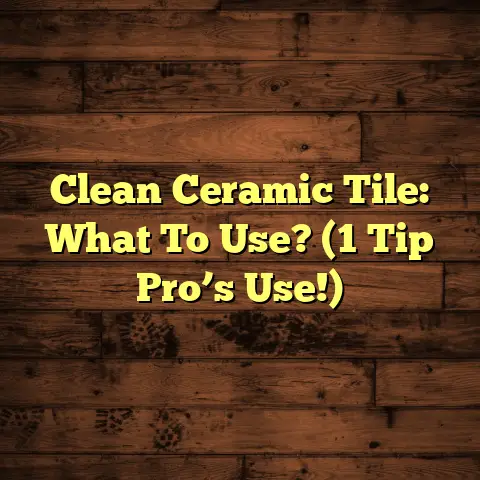Replace Bamboo Floor Board? (5 Fixes, Act Now!)
I’m John, a flooring contractor for over 15 years, and I know how much pride you take in your home.
A beautiful, functional space is key, right?
That’s why I want to talk about something near and dear to my heart (and your feet!): bamboo flooring.
It’s eco-friendly, durable, and adds a touch of elegance. But what happens when things go wrong?
Water damage, scratches, warping – the horror!
Ignoring these issues is like ignoring a leaky faucet; it only gets worse and more expensive.
Trust me, I’ve seen it all.
That’s why I’m here to give you practical solutions you can use right now to tackle those bamboo flooring woes.
Let’s dive in and keep your home looking its best!
Section 1: Understanding Bamboo Flooring
So, what exactly is bamboo flooring?
It’s made from bamboo stalks, which are processed and compressed into flooring planks.
Think of it like this: strands of bamboo are woven together and glued to create a dense, strong board.
There are a few main types:
-
Strand-woven: This is the toughest, most durable type. The bamboo strands are compressed under extreme pressure, making it super resistant to scratches and dents. It’s what I usually recommend for high-traffic areas.
-
Horizontal: The bamboo strips are laid flat, showing the knuckles of the bamboo. It has a distinctive look.
-
Vertical: The bamboo strips are oriented on their edge, creating a cleaner, more uniform appearance.
Bamboo flooring is popular because it’s:
-
Eco-friendly: Bamboo is a rapidly renewable resource.
-
Durable: Especially strand-woven.
-
Stylish: It adds a modern, natural touch to any home.
But, like any flooring, it’s not immune to problems.
Here are some common issues I see:
-
Moisture Susceptibility: Bamboo can absorb moisture, leading to swelling, warping, and even mold growth.
-
Expansion and Contraction: Changes in humidity can cause bamboo to expand and contract, leading to gaps between boards.
-
Scratches: While durable, bamboo can still be scratched by pets, furniture, and everyday wear and tear.
-
Fading: Exposure to sunlight can cause the color of bamboo flooring to fade over time.
Why is it important to address these issues quickly?
Well, besides the obvious aesthetic reasons, neglecting these problems can lead to:
-
Costly Replacements: Small issues can snowball into major problems, requiring you to replace the entire floor.
-
Safety Hazards: Warped or damaged boards can create tripping hazards.
-
Unhealthy Living Environment: Mold growth can trigger allergies and respiratory problems.
Don’t wait until it’s too late! Let’s get those floors fixed!
Section 2: Identifying the Problem
Okay, so you suspect something’s up with your bamboo floor. But what exactly is it?
Let’s play detective and figure it out!
Here’s a systematic approach I use when I’m called in for a bamboo flooring inspection:
-
Visual Inspection:
- Discoloration: Are there any dark spots, fading, or changes in color? This could indicate water damage or sun exposure.
- Warping: Are any boards lifting, buckling, or uneven? This is often a sign of moisture issues.
- Gaps: Are there noticeable gaps between the boards? This could be due to expansion and contraction.
- Scratches and Dents: Are there any visible scratches, dents, or gouges?
- Cracks: Look closely for any cracks in the boards.
-
Auditory Inspection:
- Squeaking: Does the floor squeak when you walk on it? This could indicate loose boards or subfloor issues.
-
Tactile Inspection:
- Loose Boards: Do any boards feel loose or move when you step on them?
- Uneven Surfaces: Run your hand across the floor. Do you feel any uneven areas or bumps?
Now, let’s talk about assessing the extent of the damage.
Is it just a minor scratch, or is it a full-blown warping situation?
Here are some questions to ask yourself:
- How large is the affected area? Is it just one board, or is it a larger section of the floor?
- How deep is the damage? Is it just a surface scratch, or does it penetrate the finish and into the bamboo itself?
- Is the damage structural? Does it affect the integrity of the floor?
Based on your assessment, you can determine whether a full board replacement is necessary or if repairs can suffice.
Here’s a quick guide:
| Type of Damage | Severity | Solution |
|---|---|---|
| Minor Scratches | Superficial | Scratch repair kit, stain pen |
| Deep Scratches/Dents | Moderate | Wood filler, sanding, refinishing |
| Warping | Severe | Individual board replacement, moisture control |
| Discoloration | Moderate | Refinishing, stain matching |
| Gaps | Mild | Wood filler, expansion gap adjustment |
Remember, if you’re unsure about the extent of the damage, it’s always best to consult with a professional.
I’m always happy to take a look and give you my honest opinion.
Section 3: Fix #1 – Replacing Individual Boards
Alright, so you’ve identified a damaged board that needs to be replaced. Don’t panic!
It’s a manageable DIY project.
Here’s a step-by-step guide to replacing individual bamboo floor boards:
1. Gather Your Tools and Materials:
- New Bamboo Board: Make sure it matches your existing flooring in terms of color, grain, and type.
- Pry Bar: For gently lifting the damaged board.
- Hammer: For tapping the new board into place.
- Chisel: For scoring the damaged board.
- Circular Saw or Multi-Tool: For cutting the damaged board (optional).
- Wood Glue: For securing the new board.
- Safety Glasses: Protect your eyes!
- Gloves: Protect your hands!
- Measuring Tape: For accurate measurements.
- Pencil: For marking cuts.
2. Prepare the Damaged Board:
- Score the Board: Use a chisel and hammer to score the damaged board along its length and width. This will help prevent splintering when you remove it.
- Cut the Board (Optional): If the board is difficult to remove, you can use a circular saw or multi-tool to cut it into smaller pieces. Be careful not to damage the surrounding boards.
3. Remove the Damaged Board:
- Pry it Up: Use a pry bar to gently lift the damaged board. Work slowly and carefully to avoid damaging the tongue and groove of the surrounding boards.
- Clean the Area: Remove any debris, old glue, or nails from the subfloor.
4. Prepare the New Board:
- Measure and Cut: Measure the space where the damaged board was and cut the new board to the correct size.
- Test Fit: Before applying glue, test fit the new board to make sure it fits snugly. You may need to trim it slightly.
5. Install the New Board:
- Apply Glue: Apply a thin layer of wood glue to the subfloor and the edges of the new board.
- Position the Board: Carefully position the new board into place, aligning the tongue and groove with the surrounding boards.
- Tap it In: Use a hammer and tapping block to gently tap the new board into place.
- Clean Up: Wipe away any excess glue with a damp cloth.
- Weight it Down: Place a heavy object on top of the new board to hold it in place while the glue dries.
6. Let it Dry:
- Allow the glue to dry completely according to the manufacturer’s instructions (usually 24-48 hours).
Matching New Boards with Existing Flooring:
This is crucial for a seamless look! Here are my tips:
- Source from the Same Manufacturer: If possible, purchase the new board from the same manufacturer as your existing flooring. This will ensure a consistent color and grain.
- Take a Sample: Bring a sample of your existing flooring to the store to compare it with the new boards.
- Consider a “Blend In” Approach: If you can’t find an exact match, you can try to blend the new board with the existing flooring by using a stain or finish that is slightly darker or lighter. Test the stain on a scrap piece of bamboo first to make sure it matches the desired color.
- Acclimate the New Board: Allow the new board to acclimate to the humidity of your home for several days before installing it. This will help prevent it from expanding or contracting after installation.
Safety Precautions:
- Wear safety glasses and gloves to protect yourself from flying debris and sharp edges.
- Use caution when using power tools. Follow the manufacturer’s instructions and wear appropriate safety gear.
- Work in a well-ventilated area to avoid inhaling dust and fumes.
Replacing a bamboo floor board is totally doable! Just take your time, be careful, and follow these steps.
Section 4: Fix #2 – Repairing Scratches and Dents
Scratches and dents are inevitable, especially if you have pets or kids. But don’t worry, you can fix them!
Here are some methods for repairing minor scratches and dents in bamboo flooring:
1. Scratch Repair Kit:
- These kits usually include a variety of colored wax sticks that you can use to fill in scratches.
- How to Use:
- Clean the scratched area with a damp cloth.
- Select a wax stick that matches the color of your flooring.
- Heat the wax stick with a heat gun or lighter.
- Apply the melted wax to the scratch, filling it completely.
- Remove any excess wax with a plastic scraper.
- Buff the area with a soft cloth.
2. Stain Pen:
- Stain pens are great for covering up minor scratches and blemishes.
- How to Use:
- Clean the scratched area with a damp cloth.
- Select a stain pen that matches the color of your flooring.
- Apply the stain to the scratch, following the grain of the wood.
- Wipe away any excess stain with a clean cloth.
- Let the stain dry completely.
3. Wood Filler:
- Wood filler is a good option for repairing deeper scratches and dents.
- How to Use:
- Clean the damaged area with a damp cloth.
- Apply wood filler to the scratch or dent, filling it completely.
- Let the wood filler dry completely.
- Sand the area smooth with fine-grit sandpaper.
- Apply a stain or finish to match the surrounding flooring.
4. Sanding and Refinishing:
- For more severe scratches and dents, you may need to sand and refinish the affected area.
- How to Use:
- Sand the scratched or dented area with medium-grit sandpaper.
- Feather the edges of the sanded area to blend it with the surrounding flooring.
- Apply a stain or finish to match the surrounding flooring.
Color Matching is Key!
- Test on a Scrap: Always test the stain or finish on a scrap piece of bamboo before applying it to your floor.
- Layer Colors: You may need to layer different colors of stain to achieve the perfect match.
- Consider a Professional: If you’re not comfortable with color matching, it’s best to hire a professional.
Preventive Measures:
- Use Rugs and Mats: Place rugs and mats in high-traffic areas to protect your floors from scratches and dents.
- Trim Pet’s Nails: Keep your pet’s nails trimmed to prevent them from scratching the floor.
- Use Furniture Pads: Place furniture pads under the legs of your furniture to prevent scratches.
- Avoid High Heels: High heels can dent and scratch bamboo flooring.
With a little bit of effort, you can keep your bamboo floors looking like new!
Section 5: Fix #3 – Refinishing the Floor
Over time, even the most well-maintained bamboo floors can start to look a little worn.
Refinishing can restore its original luster.
Here’s the process:
1. Preparation:
- Clear the Room: Remove all furniture, rugs, and other items from the room.
- Clean the Floor: Thoroughly clean the floor to remove any dirt, dust, or debris.
- Protect the Area: Cover any areas that you don’t want to be sanded, such as walls and trim.
2. Sanding:
- Rent a Floor Sander: You can rent a floor sander from most home improvement stores.
- Start with Coarse-Grit Sandpaper: Use coarse-grit sandpaper (40-60 grit) to remove the old finish and any imperfections.
- Move to Medium-Grit Sandpaper: Use medium-grit sandpaper (80-100 grit) to smooth out the floor.
- Finish with Fine-Grit Sandpaper: Use fine-grit sandpaper (120-150 grit) to create a smooth, even surface.
- Sand the Edges: Use an edge sander to sand the edges of the room.
- Vacuum Thoroughly: Vacuum the floor thoroughly to remove all sanding dust.
3. Staining (Optional):
- Apply Stain: If you want to change the color of your floor, apply a stain according to the manufacturer’s instructions.
- Wipe Off Excess Stain: Wipe off any excess stain with a clean cloth.
- Let it Dry: Allow the stain to dry completely.
4. Sealing:
- Apply Sealer: Apply a sealer to protect the floor from scratches, stains, and water damage.
- Apply Multiple Coats: Apply multiple coats of sealer, following the manufacturer’s instructions.
- Let it Dry: Allow the sealer to dry completely between coats.
DIY vs. Hiring a Professional:
- DIY: Refinishing a bamboo floor can be a challenging but rewarding DIY project. It can save you money, but it requires time, effort, and the right tools.
- Professional: Hiring a professional can be more expensive, but it can save you time and hassle. Professionals have the experience and equipment to refinish your floor quickly and efficiently.
Pros and Cons:
| Feature | DIY | Professional |
|---|---|---|
| Cost | Lower | Higher |
| Time | More | Less |
| Effort | More | Less |
| Skill Required | Moderate | High |
| Quality | Can vary depending on skill level | Generally higher, more consistent results |
If you’re unsure about your ability to refinish your bamboo floor, it’s always best to hire a professional.
I’ve seen too many DIY attempts gone wrong!
Section 6: Fix #4 – Addressing Moisture Issues
Moisture is the enemy of bamboo flooring. It can cause warping, swelling, and even mold growth.
Here’s how to deal with moisture-related problems:
1. Control Humidity Levels:
- Use a Dehumidifier: If you live in a humid climate, use a dehumidifier to keep the humidity level in your home below 50%.
- Ensure Proper Ventilation: Make sure your home is properly ventilated to prevent moisture buildup.
- Fix Leaks: Repair any leaks in your roof, plumbing, or windows.
2. Address Water Damage:
- Act Quickly: The faster you address water damage, the less damage it will cause.
- Remove Standing Water: Use a wet vacuum or towels to remove any standing water.
- Dry the Area: Use fans and dehumidifiers to dry the affected area.
- Replace Damaged Boards: If the water damage is severe, you may need to replace the damaged boards.
3. Prevent Future Issues:
- Use a Moisture Barrier: Install a moisture barrier under your bamboo flooring to prevent moisture from seeping up from the subfloor.
- Clean Spills Immediately: Clean up any spills immediately to prevent them from soaking into the floor.
- Avoid Wet Mopping: Avoid wet mopping your bamboo floor. Use a damp mop instead.
- Use Rugs and Mats: Place rugs and mats in areas that are prone to moisture, such as bathrooms and kitchens.
Signs of Moisture Damage:
- Warping: Boards are lifting or buckling.
- Swelling: Boards are thicker than usual.
- Discoloration: Dark spots or stains.
- Mold Growth: Visible mold or mildew.
- Musty Odor: A musty smell in the room.
If you notice any of these signs, take action immediately to prevent further damage.
I always tell my clients, “An ounce of prevention is worth a pound of cure!”
Section 7: Fix #5 – Professional Help
Sometimes, DIY just isn’t enough.
Here are scenarios where professional assistance is warranted:
- Extensive Damage: If a large area of your bamboo floor is damaged, it’s best to hire a professional.
- Structural Issues: If the damage affects the structural integrity of the floor, you need a professional.
- Moisture Problems: If you have a recurring moisture problem, a professional can help you identify the source and fix it.
- You’re Not Comfortable with DIY: If you’re not comfortable with DIY projects, don’t hesitate to hire a professional.
Choosing a Qualified Flooring Contractor:
- Get Recommendations: Ask friends, family, and neighbors for recommendations.
- Check Online Reviews: Read online reviews to see what other people have to say about the contractor.
- Verify Credentials: Make sure the contractor is licensed and insured.
- Get Multiple Quotes: Get quotes from multiple contractors before making a decision.
What to Expect During the Consultation Process:
- Inspection: The contractor will inspect your bamboo floor to assess the damage.
- Diagnosis: The contractor will diagnose the problem and recommend a solution.
- Quote: The contractor will provide you with a written quote for the work.
- Contract: The contractor will provide you with a contract that outlines the scope of work, the price, and the timeline.
Questions to Ask:
- Are you licensed and insured?
- How much experience do you have with bamboo flooring?
- Can you provide references?
- What is your warranty?
- What is your payment schedule?
Benefits of Professional Repairs vs. DIY:
- Expertise: Professionals have the expertise to properly diagnose and repair bamboo flooring problems.
- Equipment: Professionals have the right equipment to do the job quickly and efficiently.
- Warranty: Professionals typically offer a warranty on their work.
- Peace of Mind: Hiring a professional can give you peace of mind knowing that the job is done right.
Don’t be afraid to call in the pros! It can save you time, money, and headaches in the long run.
Conclusion
So, there you have it! Five fixes to tackle those bamboo flooring problems head-on.
Remember, taking immediate action is key.
Regularly inspect your floors, be proactive in addressing any issues, and don’t be afraid to seek professional help when needed.
Your bamboo floors are an investment in your home’s beauty and value.
Prioritize their maintenance, and they’ll reward you with years of stylish, durable performance.
Now go forth and conquer those flooring woes!





